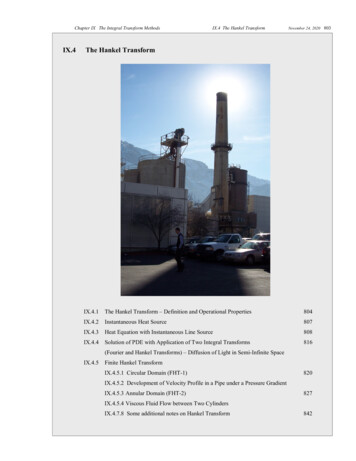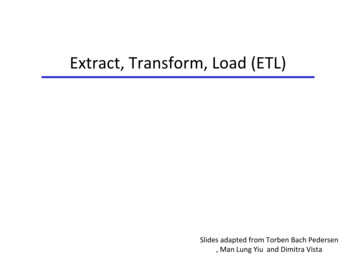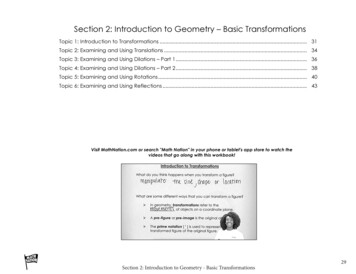
Transcription
Chapter IX The Integral Transform MethodsIX.4IX.4 The Hankel TransformNovember 24, 2020 803The Hankel TransformIX.4.1The Hankel Transform – Definition and Operational Properties804IX.4.2Instantaneous Heat Source807IX.4.3Heat Equation with Instantaneous Line Source808IX.4.4Solution of PDE with Application of Two Integral Transforms816(Fourier and Hankel Transforms) – Diffusion of Light in Semi-Infinite SpaceIX.4.5Finite Hankel TransformIX.4.5.1 Circular Domain (FHT-1)820IX.4.5.2 Development of Velocity Profile in a Pipe under a Pressure GradientIX.4.5.3 Annular Domain (FHT-2)827IX.4.5.4 Viscous Fluid Flow between Two CylindersIX.4.7.8 Some additional notes on Hankel Transform842
804Chapter IX The Integral Transform MethodsIX.4 The Hankel TransformNovember 24, 2020IX.4.1 HANKEL TRANSFORMThe physical domain where we are supposed to apply the Hankeltransform is the infinite 2-dimensional plane with polarcoordinates (r ,θ ) .The Hankel transform which we consider in this section will beapplied for transformation of the differential operatorLu Hermann Hankel(1839-1873 )1 u ν 2 r ur r r r 2(1)where ν is a parameter and domain is 0 r .The particular case of this operator with ν 0 is the radial termof Laplacian in cylindrical coordinates.We assume that the function u ( r ) is bounded for all r and thatthe function u and its derivative have radial decaying at infinity:u ( r ) , ru r 0 , r u r 0(2)r The bounded solution of the singular Sturm-Liouville problem(eigenvalue problem):Lu µ uhas non-trivial solution when the parameter is non-positive, let usrename it as µ λ 2 . That yields the equationJν ( λ r ) is a Bessel functionstof the 1 kind of order ν .Jν ( λ r ) is the bounded solutionof the Bessel Equation1 u ν 2 λ 2 u r u r r r r 2(3)which is the Bessel equation of order ν , the bounded solutionsof which are the Bessel functions of the 1st kindr 2 y ′′ ry ′ λ 2 r 2 ν 2 y 0Jν ( λ r )for r [0, )The self-adjoint form of the operator (1) is()Lu J0 ( r )J1 ( r )1 u ν 2 r u r r r r (4)Therefore, the weight function is p ( r ) r , which is used forJ2 (r )Hankel Transform of order νdefinition of the weighted inner product.Formally, the Hankel transform can be constructed from the twodimensional Fourier transform with transition to polarcoordinates and application of the integral representation of theBessel functions [Debnah]. Then the Hankel transform and theinverse Hankel transform are defined asHν { f ( r )} fν ( λ ) f ( r ) Jν ( λ r ) r d r(5)0Inverse Hankel transform of order ν{}Hν 1 fν ( λ ) f (r ) fν ( λ ) Jν ( λ r ) λ d λ0(6)
Chapter IX The Integral Transform MethodsIX.4 The Hankel TransformNovember 24, 2020 805Apply the Hankel transform (5) of order ν to δ ( r µ ) , µ 0Hν {δ ( r µ )} δ ( r µ ) Jν ( λ r ) r d r0 Jν ( λµ ) µThen δ ( r µ ) the inverse Hankel transform (6) of Jν ( λµ ) µ 1H δ (r µ )ν { Jν ( λµ ) µ } Jν ( λµ ) µ Jν ( λ r ) λ d λ0 µ Jν ( λ r ) Jν ( λµ ) λ d λ0from which follows the orthogonality of Bessel functions: Jν ( λ r ) λ d λ Jν ( λµ ) Orthogonality of Bessel functions0δ (r µ ), µ 0µ(7)Then we can formulate the Hankel Integral Theorem: f ( µ ) Jν ( λµ ) µ d µ Jν ( λ r ) λ d λ µ 0 λ 0 f (r ) The Hankel Integral Theorem (8)Proof using the orthogonality relationship (7): f ( µ ) Jν ( λµ ) µ d µ Jν ( λ r ) λ d λ λ 0 µ 0 fµ() Jν ( λµ ) Jν ( λ r ) λ d λ µ d µ µ 0 λ 0 λ (µ r) f (µ ) µ µ dµ p 0 f (r ) The Hankel integral theorem equation (8) can be used fordefinition of the Hankel transform pair (5,6). However, it shouldbe noted, that equation (8) in this notes is derived by applicationof equations (5,6) assuming that they are true. We can state thereis no circular reasoning (derivation of the result starting withassumption that it is true), if equations (5,6) are originated fromsome external derivation, for example, by the change of variablesin Fourier transform to polar coordinates.
806Chapter IX The Integral Transform MethodsProperties of Hankel transformIX.4 The Hankel TransformNovember 24, 2020Both, the Hankel transform and its inverse are linear operators.Hν { f ( ar )} H0 { 1 } 1 λ fν a2 a scalingδ (λ )λ e ar H0 r δ ( r c ) H0 r H 0 { H ( a r )}{ }1 4cλ e2c{ } H0 e cr 2H 1 e ar2λ(a2 λ2 )3 e ar H1 r H0 { r f ′ ( r ) }H0{ f (r ) }0Have to be checked! 2 f0 ( λ ) λ f0′ ( λ ) f (λ )reciprocity
Chapter IX The Integral Transform MethodsOperational PropertyNovember 24, 2020 807IX.4 The Hankel TransformConsider application of the Hankel trnsform of order ν todifferential operator (1), in which the additional term defines theorder of the applied Hankel transform: 1 u ν 2 Hν r 2 u r r r r 1 u ν 2 rJν (λr ) r 2 u dr0 r r r r Jν (λr )0 u r dr r r u Jν (λr )d r r 0 u[Jν (λr )]′dr r0 ′ r [Jν (λr )] duFrom self-adjoint form ofthe Bessel Equation: ν2 λ 2 r y 0r { ( ry ′ )′ write0ru Jν ( λ r ) ′} 0{ { ud r Jν ( λ r ) 0′}}′ ′ u r Jν ( λ r ) dr ν2 ( ry ′ )′ r 2 λ 2 y r Then for y Jν ( λ r )0 ν2 r ) ′ r λ 2 2 Jν ( λ r ) rJν′ ( λ r u dr ν 2 rJν ( λ r ) 2 r0 u dr ν 2 rJν ( λ r ) 2 u dr r 0 u u r Jν (λr ) r d [Jν (λr )] r 0 0 r r ν 2 rJν ( λ r ) 2 r0 ν 2 rJν ( λ r ) 2 r0 u dr ν 2 rJν ( λ r ) 2 r0 u dr ν 2 rJν ( λ r ) 2 u dr r 0 ν 2 rJν ( λ r ) 2 u dr r 0 ν 2 ur 2 λ2 Jν (λr )dr0 r ν 2 rJν ( λ r ) 2 u dr r 0 ν 2 λ2 r Jν (λr )udr rJν (λr ) 200 r u dr ν 2 rJν ( λ r ) 2 r0 u dr λ2 r Jν (λr )udr0 λ 2 uν ( λ ) ν2 Hν 2 2 u ( r ) r 1 u ν 2rJλr() r 2 ν0 r r r r u dr λ 2 uν ( λ )(9)0th order and 1st order Hankel Transforms 1 u H0 r r r r 1 u rJ 0 ( λ r ) r r r r dr 0 λ 2 u 0 (λ ) 1 u u 1 u u 2rJ 1 ( λ r ) H1 r r 2 dr λ u1 ( λ ) 2 r r r r r r r r 0 u0 (λ ) rJ 0 ( λ r ) u ( r ) dr0th order0 u1 ( λ ) rJ 1 ( λ r ) u ( r ) dr 1st order0We will use mostly the 0th order Hankel transform (in this case, index 0 in the transformed function is usually omitted)
808Chapter IX The Integral Transform MethodsIX.4 The Hankel TransformNovember 24, 2020EXAMPLE TRANSIENT HEAT TRANSFER Cooling of the bell-shaped temperature profileConsider the axisymmetric case of the Heat Equation incylindrical coordinates 2u u0 ( r ) e br21 u 1 u r r r r α tu ( r,0 ) u e br0 (r )r [0, ) t 02(initial condition)There are no boundary conditions, but we assume that thefunction u and its derivative has radial decaying at infinity: u 0ru r 0 r r r Physically it can be treated as a heated to bell shaped temperatureprofile infinite flat plate thermoinsulated from both sides.Heat is conducted along the plate.infinite metalplate1) Transformed equation Apply 0th order Hankel transform u ( λ , t ) rJ 0 ( λ r ) u ( r,t ) dr0Then equation is transformed to1 u λ 2 u α tWith transformed initial condition (see p.806) u (λ ,0 ) rJ 0 ( λ r ) u0 dr0 e 4b2brJ ( λ r ) e dr br 20λ20That is the 1st order linear ODE u αλ 2 u 0 tThe solution is 1 1 4b α t λ 2e2b2) Inverse transform Solution of the problem (use table p.806)Hankel example p.808.mwsu ( r,t )u ( λ ,t ) u ( λ ,0 ) e αλ tu (r ,t ) 1 1 α t λ 2 H 0 1 e 4b 2b 2 λ2 1 41 1 b 4α tH 0 e 2b λ22c 1 1 4c H0 e2b2c 1c cr 2 e e b14α bt ) ( u (r ,t ) denote c 1e(1 4α bt ) r2 1 4αt b 11 4αtb r2 1 4αt b
Chapter IX The Integral Transform MethodsIX.4 The Hankel TransformNovember 24, 2020 809IX.4.2 INSTANTENEOUS ENERGY SOURCE We consider the volumetric heat source S (r ,t ) which releases itsentire energy spontaneously at the time t t0 at the points r r0[Ozisik, HC, p.220]. W s gIn the axisymmetric case (does not depend on θ ) of cylindricalg S ( r,t ) δ ( r r0 ) δ ( t t0 ) m 2π rcoordinates and no dependence on the z coordinate (the samesource strength for any plane perpendicular to the z axis), this is acylindrical surface heat source which can be represented withthe help of the Dirac delta functiong W δ (r r0 )δ (t t0 )S (r ,t ) m3 2πr W s m is the source strength per unit length g W s m 2 is the source strength per unit area2πr [m]the variable r appears in therdenominator as a scale factor of thetransformation to polar coordinates 1 δ (r r0 ) defines the radius of the source r r0 m 1 δ (t t0 ) defines the moment of time t t0 s Integrated over the entire time-space domain (in the planeperpendicular to the z coordinate), it should yield the strength ofthe heat source (conservation of energy):where W s g m S ( r,t ) gδ ( r ) δ ( t t0 )2π rg [W s ]g 2π gS ( r,t )2π rδ ( r ) δ ( z z0 ) δ ( t t0 ) S (r ,t )rdrdθdt0 0 0 2π g2π 2π g2π 2πg 2π2π rδ ( r r0 ) δ ( z z0 ) δ ( t t0 ) δ (r r0 )δ (t t0 )drdθdt0 0 0 δ (t t0 )dθdt0 02π dθ0g[θ ]02π 2π gg [W s ]g 0 0 0 S ( r,t ) g 2πr δ (r r0 )δ (t t0 ) rdrdθdtIn the 3-dimensional case, the heat source is a circular ring inthe plane z z0 defined bygδ (r r0 )δ (z z0 )δ (t t0 )S (r ,t ) 2πrAn instantaneous source is used for finding the Green functionfor the non-homogeneous PDE. The heat source for HE equationis defined byS ( r,t )kwhere W k is a thermal conductivity of the medium and m K W S 3 is a volumetric heat generation rate. m
810Chapter IX The Integral Transform MethodsIX.4 The Hankel TransformNovember 24, 2020IX.4.3 HEAT EQUATION WITH INSTANTENEOUS LINE SOURCEConsider the axisymmetric case of the Heat Equation incylindrical coordinates with the instantaneous line source locatedat r r0 0 (line source in 3-D)r r0 0 2u 1 u g2 uδ (r )δ (t t0 ) r [0, ) t 0 r a t 2πrkr r r u (r ,0 ) u0 (r ) 0(initial condition)There are no boundary conditions but we assume that thefunction u and its derivative has radial decaying at infinity: u 0ru r 0 r r r 1) Transformed equation Apply zero order Hankel transform u (λ ,t ) rJ 0 (λr )udr0to the equation and initial condition ug λ2 u a 2δ (t t0 ) u (λ ,0 ) rJ 0 (λr )u0 dr 0 t 2πk0this is the 1st order linear ODE u λ2g u δ (t t0 ) t a 22πa 2 kThe solution by variation of parameteruS ( r,t ) g2π r u (λ ,0 )e λ2a2t e λ2 tta2λ2 ea2t0 λ2δ ( r ) δ ( t t0 ) g 2πa 2 k δ (t t0 ) dt λ2ttg22 0e a e a H (t t0 )22πka2 λ(t t0 )ga2 eH (t t0 )22πka2) Inverse transformu (r ,t ) λ J 0 ( λ r ) u ( λ ,t ) d λ0 λ2g2ea22πka λ J0 ( λ r ) 0( t t0 ) H ( t t0 ) d λ λ2 g2H ( t t0 ) λ J 0 ( λ r ) e a2π ka 20( t t0 )dλ a 2r 2ga2() Htte 4 (t t0 )02(t t0 )2πka 2 a 2r 2g H (t t0 ) 4 (t t0 )e 4πk (t t0 )The solution can be rewritten also in the formSolution for u0 0 and r0 0 (H-1.mws)0 a2 r 2u ( r,t ) g4 ( t t0 )e 4π k ( t t0 )t t0t t0
Chapter IX The Integral Transform MethodsCylindrical heat sourceNovember 24, 2020 811IX.4 The Hankel Transform3)Case r r0 0 2u 1 u g2 u δ (r r0 )δ (t t0 ) r ar r r t 2πrk λ2 u a 2 ug δ (t t0 )J 0 (λr0 ) t 2πk u (λ ,0 )eu λ2a2t e λ2 tta2 e02 λ λ2a2t g 2πa 2 k δ (t t0 )J 0 (λr0 ) dt 2λttg22 0e a e a J 0 (λr0 )H (t t0 )22πka2 λ(t t0 )ga2 eJ 0 (λr0 )H (t t0 )22πkau (r ,t ) λJν (λr )u (λ ,t )dλ0 λ2 g (t t0 )a2 dλ()()eJλrHtt λJν (λr ) 000 2πka 2 0 2 λ (t t0 )ga2)()()(λλλHttJrJredλ ν000 2πka 20integration in [Ozisik, p.161, eqn(3-151)] a 2 rr0 a2g() HttI e00 2(t t0 ) 2(t t0 ) 2πka 2 a 2 rr0 g I0 e4πk (t t0 ) 2(t t0 ) Solution for u0 0Green’s Function( a 2 r 2 r024 (t t0 ) a 2 rr0 gI0 u (r ,t ) e4πk (t t0 ) 2(t t0 ) ()( a 2 r 2 r024 (t t0 ))H (t t0 ) a 2 r 2 r024 (t t0 ))H (t t0 )This is the Green function for the Heat Equation in cylindricalcoordinates.
812H-1.mwsChapter IX The Integral Transform MethodsIX.4 The Hankel TransformNovember 24, 2020Hankel transform solution of Heat Equation with instanteneous point source r0 0 restart; with(plots): it: int(exp(-lambda 2*(t-t0)/a 2)*BesselJ(0,lambda*r)*lambda,lambda 0.infinity): u(r,t): g*it/2/Pi/k;u( r, t ) : g: 1;a: 2;t0: 1;k: 1;2 a 2 r 2 4 ( t t0 ) 1 ga e4 ( t t0 ) π kg : 1a : 2t0 : 1k : 1 u2(r,t): subs(r -r,u(r,t)): u1(r): subs(t 1.01,u2(r,t)):u2(r): subs(t 1.05,u2(r,t)):u3(r): subs(t 1.1,u2(r,t)): plot({u1(r),u2(r),u3(r)},r -0.5.0.5,axes boxed,color black);t 1.01t 1.05t 1.1 animate(u(r,t),r -0.5.0.5,t 1.002.1.2,frames 300);for animation oftemperature profilesee web site animate3d([r,theta,u(r,t)],r 0.0.4,theta 0.2*Pi,t 1.004.1.2,frames 200,style wireframe,coords cylindrical);for animation oftemperature profilesee web site
Chapter IX The Integral Transform MethodsIX.4 The Hankel TransformNovember 24, 2020 813Heat Equation with the instantantenous cylindrical source with r0 1 restart; g: 1;a: 2;t0: 0;r0: 1;k: 1;g : 1a : 2t0 : 0r0 : 1k : 1 u(r,t): g/4/Pi/(t-t0)*BesselI(0,a 2*r0*r/2/(t-t0))*exp(-(r 2 r0 2)/4/(t-t0)*a 2); 2 r BesselI 0 , e1t u( r, t ) : 4πtr 2 1 t u2(r,t): subs(r -r,u(r,t)): u1(r): subs(t 0.01,u2(r,t)):u2(r): subs(t 0.25,u2(r,t)):u3(r): subs(t 2.0,u2(r,t)): plot({u1(r),u2(r),u3(r)},r -4.4,axes boxed,color black);t 0.01t 0.25t 2.0 with(plots): animate(u(r,t),r -5.5,t 0.002.3,frames 300);for animation oftemperature profilesee web site animate3d([r,theta,u(r,t)],r 0.2.5,theta 0.2*Pi,t 0.004.3,frames 200,style wireframe,coords cylindrical,color black);for animation oftemperature profilesee web siteH-1-3.gif
814IX.4.5Chapter IX The Integral Transform MethodsTHE WAVE EQUATIONIX.4 The Hankel TransformNovember 24, 2020(vibration of axisymmetric infinite membrane) 2u 1 u 1 2 u r r r r a 2 t 2r [0 , ) t 0i.c. u (r ,0 ) u0 (r ) u (r ,0 ) u1 (r ) t1) Transformed equation Apply zero order Hankel transform u (λ ,t ) rJ 0 (λr )u (r ,t )dr0to the equation and initial condition λ2 u 1 2ua 2 t 2this is the 2ndu (λ ,0 ) rJ 0 (λr )u0 dr u00 u(λ ,0 ) rJ 0 (λr )u1dr u1 t0order linear ODE 2u a 2 λ2 u 0 t 2General solutionu c1 cos(aλt ) c2 sin(aλt )u ′ aλc1 sin(aλt ) aλc2 cos(aλt )Initial conditions:u (λ ,0 ) u0 c1 u(λ ,0 ) u1 aλc2 c2 u1 taλSolution:u u0 cos(aλt ) u1sin(aλt )aλ2) Inverse transform:Solution of the problem is given by the inverse Hankel transform u (r ,t ) λJ 0 (λr )u0 (λ ) cos(aλt )dλ 01 λJ 0 (λr )u1 (λ ) sin(aλt )dλa 0
Chapter IX The Integral Transform MethodsNovember 24, 2020 815IX.4 The Hankel Transform3) Maple example (Hankel-1.mws):Let the membrane have initially the bell shape and u1 ( r ) 0 :1u0 (r ) Aor u0 ( r ) 2r 12r sThe Hankel transform of this function isu0 (λ ) e λλu0 ( λ ) Ae sλλAssume also zero initial velocity of the membraneu1 (r ) 0Then the solution of this problem is given by the following integral u (r ,t ) J 0 (λr )e λ cos(aλt )dλ0[I.S.Gradstein, I.M.Ryzhik, Table of Integrals #6.751.3](1)2 2 2b c 2 a 2 4 a 2b 2 b 2 c 2 a 2 bλ J 0 (cλ )e cos(aλ )dλ 2 22 22202 b c a 4a b()identify: a at b 1 c rThen the solution becomes:(1) 22 2 22 222 2 2 1 r a t 4 a t 1 r a t u (r ,t ) 22 1 r 2 a 2t 2 4 a 2t 2()
816Chapter IX The Integral Transform MethodsHankel-1.mwsIX.4 The Hankel TransformNovember 24, 2020Wave equation - vibration of the infinite membrane restart; with(plots):Initial condition: u0(r): 1/sqrt(r 2 1);u0 ( r ) : 12r 1 cylinderplot([r,theta,u0(r)],r 0.6,theta 0.2*Pi);Hankel transform of initial condition: ub0(lambda): simplify(factor(int(r*BesselJ(0,lambda*r)*u0(r),r 0.infinity)));( λ )eub0 ( λ ) : λ v: 2;v : 2Solution - inverse Hankel transform: u(r,t): ambda*t),lambda 0.5);5( λ )cos ( 2 λ t ) d λu( r, t ) : BesselJ ( 0 , λ r ) e 0Table of integrals [Gradshtein, Ryzhik #6.751.3] b: -1;a: -v*t;c: r;b : -1a : 2 tc : r u(r,t): sqrt(sqrt((b 2 c 2-a 2) 2 4*a 2*b 2) b 2 c 2-a 2)/sqrt((b 2 c 2-a 2) 2 4*a 2*b 2)/sqrt(2);u( r, t ) : 1 2 r 2 8 t 2 r 4 8 r 2 t 2 16 t 4 1 r 2 4 t 22222 241 2 r 8 t r 8 r t 16 t24 u2(r,t): subs(r -r,u(r,t)): u1(r): subs(t 0.01,u2(r,t)):u2(r): subs(t 2.0,u2(r,t)):u3(r): subs(t 5.0,u2(r,t)):u4(r): subs(t 10.0,u2(r,t)): plot({u1(r),u2(r),u3(r),u4(r)},r -30.30,axes boxed,color black);t 0.01t 2.0t 5.0t 10.0
Chapter IX The Integral Transform MethodsIX.4 The Hankel TransformNovember 24, 2020 817 animate({u2(r,t),u(r,t)},r -40.40,t 0.20,frames 200);for animationsee web site animate3d([r,theta,u(r,t)],r 0.40,theta 0.2*Pi,t 0.20,frames 100,style wireframe,coords cylindrical);for animationsee web site animate3d([r,theta,u(r,t)],r 0.40,theta 0.2*Pi,t 0.20,frames 100,style patchnogrid,coords cylindrical);for animationsee web site
818Chapter IX The Integral Transform MethodsIX.4.6IX.4 The Hankel TransformNovember 24, 2020Solution of PDE with application of two integral transforms (Fourier and Hankel transforms)Diffusion of light (heat) in semi-infinite spaceConsider a problem of diffusion of light in the half-space z 0with instantaneous point sourceS (r ,t ) Qδ (r )δ (z z0 )δ (t )2πrSince the problem has the angular symmetry in the xy-plane, it isreasonable to consider it in the cylindrical coordinates. In thepurely scattering medium, the diffusion approximation of lightpropagation is described by the following equation:instanteneouspoint sourceδ (r )1 ϕ 1 1 ϕ 1 2ϕQ δ (z )δ (t ) r 2c t d r r r d z2πrThe boundary condition describes partial reflection of light fromthe surface and partial escape of the light through the surface ϕ d z hϕ 0 z 0Initial condition:ϕ t 0 0whereϕ (r , z , t )d 3(1 g )µµgcQh R1 1 R2 1 RH fluency describes the radiation fielddiffusion coefficientscattering coefficientanisotropy factorspeed of lightsource powersurface reflectivity (optical property)hdDetermine what type of integral transform to use:The Laplacian includes derivatives w.r.t. two variables: Fourier standard transformz [0, ) (Robin b.c)r [0, )Fourier standard transform Hankel transform ϕ (r , ω , t ) ϕ (r , z , t )K (ω , z )dz0 ϕ (r , z , t ) ϕ (z , ω , t )K (ω , z )dω0ω cos ωz H sin ωzK (ω , z ) N (ω )N (ω ) Hankel transformπ2(ω2 H2) ϕ (λ , ω , t ) rJ 0 (λr )ϕ (r , ω , t )dr0 ϕ (r , ω , t ) λJ 0 (λr )ϕ (λ , ω , t )dλ0121 N 2 π ω2 H 2
Chapter IX The Integral Transform MethodsNovember 24, 2020 819IX.4 The Hankel TransformApply integral transforms to the equation and initial condition: ω δ (z )K (ω , z )dz N (ω )1) Fourier Transform0Q ωδ (r )1 ϕ 1 1 ϕ ω 2δ (t )ϕ rrc t d r r r d2π N (ω ) rJ 0 (λr )2) Hankel Transformδ (r )0rdρ 1transformed equationQ ω1 ϕ λ 2 ω 2 ϕ δ (t )2π N (ω )c tdsolution by variation of parameterϕϕ3) Inverse Hankel Transformϕ4) Inverse Fourier Transform dQd 4 ct re2π 2t2 0 d2 d2 Qd 4 ct re2π 2t Qd 4 ct re2π 2 t Qd 4 ct r 2e2π 2 t d (ω2t 0 0 cc τ (λ ω ) t (λ ω ) τcQ ωddδ (τ )dτee 2π N (ω )0 c (λ ω ) tcQ ωde2π N (ω ) ω 2 t λ2 tcQ ωe d λJ 0 (λr )e d dλ2π N (ω )0 ωcQ ωe2π N (ω ) ωQd 4 ct r ωee4πtN (ω ) Qd 4 ct r 2 ω ω 2 d te N (ω ) e K (ω , z )dω4πt0 Qd 4ct r 2 ω ω cos ωz H sin ωz ω 2 d teedω N (ω )N (ω )4πt0 Qd 4 ct r 2 ω 2 cos ωz Hω sin ωz ω 2 d teedω ω2 H 22π 2t0222222c d2cctd dd 4ct re2ct222ctdc dc dϕ (r , z , t ) Solutionϕc d dQd 4 ct re2π 2t2 ω 2 cos ωz Hω sin ωz ωe ω2 H 20) H 2 H 2 cos ωz Hω sin ωz ωeω2 H 2 H 2 cos ωz Hω sin ωz ωωcosz 2 e ω2 H 2ω H2 0 22ctdctd2ctddωdωdωccc ω t ω t ω sin ωz ω d t 2 cos ωz e d dω H 2edω [cosωz ]e d dω H 22 2 0 0 ω H 0 ω H cc 1 πd z d ω sin ωz ω d t cosωz ω d te 4 ct H 2 2edω H 2edω 2 2 2 ct 0 ω H 0 ω H 222222
820Chapter IX The Integral Transform MethodsSI-7b.mwsIX.4 The Hankel TransformNovember 24, 2020Diffusion of Radiation in the semi-infinite space from instantaneous point source restart;with(plots):Fluency: phi: Q*d/2/Pi 2/t*exp(-d*r 2/4/c/t)*(1/2*sqrt(Pi*d/c/t)*exp(z 2*d/4/c/t)-H 2*int((cos(omega*z))/(omega 2 H 2)*exp(omega 2*c*t/d),omega 0.25) int((H*omega*sin(omega*z))/(omega 2 H 2)*exp(omega 2*c*t/d),omega 0.25));φ : 1Qde22 1 /4 d r c t 1 2 πdect2 1 /4 z d c t 25 2 ω c t d cos(ωz)e2 H dω ω2 H2 025 ω 2 c t d H ω sin( ω z ) e d ω 22 ω H 0 d: 1;c: 300000000;Q: 1;H: 10;G: 10000000;d : 1c : 300000000Q : 1H : 10G : 10000000 f1: subs(t 0.000000001,phi)/G: f2: subs(r -r,f1): plot3d({f1,f2},r -2.2,z 0.2,axes boxed);distribution of fluencyin the mediumat t 10 -9Reflection – fluency at the surface z 0 - light exiting the layer: R(r): subs(z 0,f1): RR(r): subs(r -r,R(r)): plot({RR(r),R(r)},r -2.2);t 10 -9( π2 t )
Chapter IX The Integral Transform MethodsIX.4 The Hankel TransformNovember 24, 2020 821 densityplot({f1,f2},r -2.2,z 0.2,axes boxed,style patchnogrid);time 10 -10 densityplot({f1,f2},r -2.2,z 0.2,style patchnogrid);time 10 -9 R1: subs(z 0,phi)/G: R2: subs(r -r,R1): animate({R1,R2},r -2.2,t 0.0000000001.0.000000001,frames 100);for animation ofreflection profilesee web site
822Chapter IX The Integral Transform MethodsIX.4 The Hankel TransformNovember 24, 2020IX.4.7 FINITE HANKEL TRANSFORMCIRCULAR DOMAIN – SOLID CYLINDERIX.4.7.1 Circular DomainThe Hankel transform which we consider in this section will beapplied for transformation of the differential operator1 u ν 2(1)Lu r ur r r r 2where ν is a parameter and domain is 0 r r1 .The particular case of this operator with ν 0 is the radial termof Laplacian in cylindrical coordinates.We assume that the function u ( r ) is bounded for all r and it0r1rsatisfies a boundary condition at r r1 (which can be one of thethe three types):u ( r1 ) f(2) u ( r1 ) f r u f k r hu r r1The self-adjoint form of operator is1 u ν 2 r u r r r r Lu Supplemental Sturm-Liouville problem.The singular eigenvalue problem for considered operator appliedto function R ( r ) isLR λ Rsubject to one of homogeneous boundary conditions R R ( r1 ) 0 , R ′ ( r1 ) 0 , or k0 hR r r r1and it should be bounded R ( 0 ) at the center.Equation can be rewritten in Sturm-Liouville form as ν2 ( λ ) r R 0 r ( rR′ )′ has non-trivial solution when the parameter is non-positive, let usrename it as λ 2 , and the weight function is p ( r ) r .That yields the equationJ0 ( r )J1 ( r )()r 2 R ′′ rR ′ λ 2 r 2 ν 2 R 0J2 (r )(3)which is the Bessel equation of order ν , the bounded solutionsof which are the Bessel functions of the 1st kindR ( r ) Jν ( λ r )Application of boundary conditions (see Chapter VII, p.502)yields the characteristic equations for eigenvalues λn , and thecorresponding eigenfunctionsRn ( r ) Jν ( λn r )
Chapter IX The Integral Transform MethodsInner product Vector SpaceIX.4 The Hankel TransformNovember 24, 2020 823Inner product and the norm are defined asr1( u,v ) p u ( r ) v ( r ) r dr0r1u,u ) p u 2 ( r ) r dr( 2 u p0According to SLT, the set of eigenfunctions {Jν (λn r )} is orthogonal onr [0 , r1 ] with the weight function r and can be used for Fourier-Besselexpansion of the function u: u (r ) cn Jν (λn r )wheren 1r1r1 u (r )Jν (λn r )rdr u (r )Jν (λn r )rdrcn 0 r 02Jν (λn r )2()rdrrJλn 10νIf we rearrange the coefficients in the expansion r1 u (r )Jν (λn r )rdr r1 J (λ r ) u (r )J (λ r )rdr Jν (λn r )u (r ) 0 νnνn 22 n 1 n 1 0Jν (λn r ) Jν (λn r ) then the integral transform pair of order ν can be defined asHν { u } Finite Hankel Transform (FHT)r1u n u (r )Jν (λn r )rdr0 Hν 1 { un } u ( r ) unInverse Finite Hankel Transformn 1Jν ( λn r )Jν ( λn r )2with the inverse transform in the from of an infinite series.Because functions Jν (λn r ) are solutions of SLP, they are solutions of BE ′ ν2 rJν′ ( λn r ) λn2 r Jν ( λn r ) 0r or it can be rewritten as ′ ν 2 rJν′ ( λn r ) λn2 r Jν ( λn r ) r and satisfy one of the homogeneous boundary conditions:I)DirichletII) Neumannν k Jν 1 ( λn r1 ) λn Jν ( λn r1 ) h ?r III) RobinJν (λn r1 ) 0Jν′ (λn r1 ) 0hkJν′ (λn r1 ) hJν (λn r1 ) 0 or Jν′ (λn r1 ) Jν (λn r1 )k
824Chapter IX The Integral Transform MethodsIX.4 The Hankel TransformNovember 24, 2020Operational property of Finite Hankel TransformConsider the differential operator with respect to radial variable r1 u ν 2u r r r r r 2which is the objects for elimination with the help of FHT. Apply FHT of order ν 1 u ν 2Hν r 2 r r r r r1 u 1 u ν 2 r r r r r 2 u Jν ( λn r ) rdr0 r1r1 ν 2 1 u r Jν (λn r )rdr 2 u Jν (λn r )rdr0 r0 r r r rr12 u 1 ν Jν (λn r )d r 2 u Jν (λn r )rdr r 0 r 0rr1r11 ν 2 u u r Jν (λn r ) rJν′ (λn r )dr 2 u Jν (λn r )rdr r 0 0 r0 r rr11 ν 2 u r Jν (λn r ) rJν′ (λn r )du 2 u Jν (λn r )rdr r r1 0 r 0 r rr11 ν 2 u r′ r Jν (λn r ) [rJν′ (λn r )u ]01 u[rJν′ (λn r )] dr 2 u Jν (λn r )rdr r r1 r 0 r0 rr ν 2 ν 2 u r Jν ( λn r ) rJν′ ( λn r ) u r r u λn2 r Jν ( λn r ) dr 2 r r r 0 0 r r1111 u Jν ( λn r ) rdr rrr ν 2 ν 2 u r Jν ( λn r ) rJν′ ( λn r ) u r r λn2 uJν ( λn r ) rdr 2 u Jν ( λn r ) rdr 2 u Jν ( λn r ) rdr r r r 00 r0 r11111 r1 u rr r1Jν ( λn r1 ) r1 Jν′ ( λn r1 ) u ( r1 ) λn2 unfor any of I, II, or III type of b.c.
Chapter IX The Integral Transform MethodsIX.4 The Hankel TransformNovember 24, 2020 825For the particular type of boundary conditions, the result can be specified as following:u ( r1 ) f1 ( t )0r1ru (r1 ) f 1 (t )I DirichletJν (λn r1 ) 0Eigenvalues λn are the positive roots ofJν ( λ r1 ) 0EigenfunctionsRn ( r ) J 0 ( λn r )NormOperational propertyRn ( r )2 r12 2Jν 1 ( λn r1 )22 I 1 u ν2 Hν( ) r 2 u r1λn Jν 1 ( λn r1 ) f1 ( t ) λn un r r r r 2 I 1 u ν r1λn Jν 1 ( λn r1 ) f1 ( t ) λn2 un Hν( ) r 2 u rrrr Fourier-Bessel seriesr1un u ( r ) Jν ( λn r ) r drFinite Hankel Transform0 u ( r ) unn 1Derivation of operational propertyJν ( λn r )Jν ( λn r )2Inverse Hankel Transform2 uI 1 u νHν( ) Jν ( λn r1 ) r1 Jν′ ( λn r1 ) u ( r1 ) λn2 un r 2 u r1 r r r r r r r r1 Jν′ ( λn r1 ) f1 ( t ) λn2 un1 ν r1λn Jν 1 ( λn r1 ) Jν ( λn r1 ) f1 ( t ) λn2 unλrn 1 r1λn Jν 1 ( λn r1 ) f1 ( t ) λn2 unor if the other recurrence formula is used, then νJν ( λn r1 ) f1 ( t ) λn2 un r1λn Jν 1 ( λn r1 ) λn r1 r1λn Jν 1 ( λn r1 ) f1 ( t ) λn2 un
826Chapter IX The Integral Transform Methods u ( r1 ) r0r1IX.4 The Hankel TransformNovember 24, 2020 f1 ( t )rII Neumann u (r1 ) f 1 (t ) rJν′ (λn r1 ) 0 or λJ ν 1 (λL ) ν 0νJ ν (λL ) 0LEigenvalues λn are theλ0 0and the positive roots of λJ ν 1 (λL ) EigenfunctionsR0 1νL(Ch.VII, p.507)J ν (λL ) 0Rn ( r ) J 0 ( λn r )2Norm:R 0r1rdr 0r1222Rn ( r)ν 0Eigenvalues λn are theλ0 0and the positive roots ofJ 1 (λL ) 0 ,Eigenfunctions:R0 1r122 ν2 1 2 2 λn r1 2 Jν ( λn r1 ) Rn ( r ) J 0 ( λn r )2Squared Norm:R 0r1rdr 02Rn ( r ) Operational Property 1 u ν 2Hν 0 r 2 r r r r u r1r122J 02 ( λn r ) rdr 0r12 2J 1 ( λn r1 )2 0,n 0 1 u ν 2 r1 Jν ( λn r1 ) f1 ( t ) λn2 un ,Hν 0 r 2 u r r r r n 1,2,. 1 u 0 2 Hν 0 r 2 u r r r r n 0 r1 f1 ( t ) 1 u 0 2 r1 J 0 ( λn r1 ) f1 ( t ) λn2 unHν 0 r 2 u r r rr n 1,2,.
Chapter IX The Integral Transform MethodsNovember 24, 2020 827IX.4 The Hankel TransformThe case ν 0 ,λ0 0, λn 0, n 1,2,.Characteristic equationJ 1 ( λn r1 ) 0Eigenfunctionsy0 ( r ) 1λn are the roots of the equation J 1 ( λ r1 ) 0yn ( r ) J 0 ( λn r )2y0 ( r ) Squared norm2yn ( r ) r122r12 2J 0 ( λn r1 )2r1u0 u ( r ) rdrFHTFor u const ,u0 ur10r1un u ( r ) J 0 ( λn r ) rdrun u0Inverse FHT u (r )u (r )Operational Propertyu0J 0 ( λ0 r )22u 22 0r1r1 un2n 1 un 1nJν ( λn r )Jν ( λn r )2J 0 ( λn r )J 02 ( λn r1 )02 II 1 u r1 J 0 ( λn r1 ) f1 ( t ) λn2 un Hν( 0) r 2 u r r rr 02II 1 u Hν( 0) r 2 r r r rDIDIER / 00 Hajduk Finite Hankel example u r1 f1 ( t )n 1,2,.n 0J 1 ( λn r1 )λn 0
828Chapter IX The Integral Transform Methodsk0 u ( r1 ) rr1IX.4 The Hankel TransformNovember 24, 2020 hu ( r1 ) f1 ( t )rEigenvalues λn are the positive roots ofEigenfunctionsNormIII Robin u (r1 ) hu (r1 ) f 1 (t ) rkJν′ (λn r1 ) hJν (λn r1 ) 0 orhJν′ (λn r1 ) Jν (λn r1 )kν λ Jν 1 ( λ r1 ) H Jν ( λ r1 ) 0L λ J 1 ( λ r1 ) H J 0 ( λ r1 ) 0ν 0ν 0Rn ( r ) J 0 ( λn r )2Rn ( r )2R n (r )Fourier-Bessel serieskr122 H2 ν2 2 1 2 2 λn λn r1 2 Jν ( λn r1 ) ν 0 r12 H 2 1 J 02 ( λn r1 ) 2 λn2 ν 0r1un u ( r ) Jν ( λn r ) r drFinite Hankel Transform0 u ( r ) unn 1Jν ( λn r )Jν ( λn r )Inverse Hankel Transform2Operational property2f1 ( t ) I 1 u ν λn2 unHν( ) r
Nov 24, 2020 · Chapter IX The Integral Transform Methods IX.4 The Hankel Transform November 24, 2020 809 IX.4.2 INSTANTENEOUS ENERGY SOURCE We consider the volumetric heat source . S (r,t) which releases its entire energy spontaneously at th










